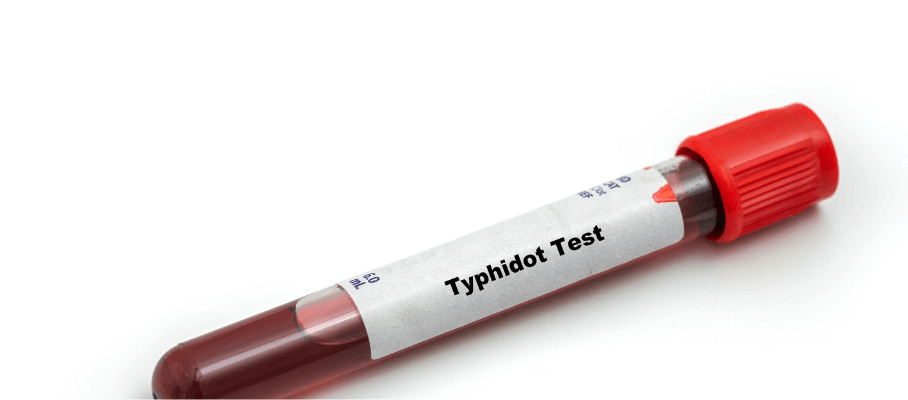Disease
Typhidot Test: Procedure, Preparation, & Report
158554 Views
0

What is a Typhidot Test?
The Typhidot test is a rapid serological test that assists medical professionals in diagnosing typhoid fever. A bacterium called Salmonella Typhi causes this fever. When this bacterium enters your body, your immune system releases two types of antibodies, IgG and IgM, to fight against the bacteria. Typhidot test is a ready-to-use dot ELISA kit designed for qualitative detection and differentiation of these antibodies separately against the outer membrane protein (OMP) of the Salmonella Typhi bacterium.
Typhoid is one of the most prevalent diseases in Indian settings. The fever spreads through contaminated food, drinks, and drinking water. It is a life-threatening illness that needs rapid diagnosis to ensure appropriate treatment of potential carriers and prevent Typhoid outbreaks.
Most of the detection methods fail to show accurate results. To confirm the presence of the bacteria, many patients are required to undergo ELISAs (enzyme-linked immunosorbent assays) and other blood cultures several times. Another diagnostic measure is bone marrow culture. But, it is too invasive and cannot be performed in a laboratory setting. In this respect, the typhidot test has proved to be an extremely valuable diagnostic tool.
What is the Typhidot Test used for?
Doctors routinely order a Typhidot test to evaluate people who exhibit the following symptoms:
- Fever with body pain, especially in the head and legs
- Increased weakness and sleepiness
- Gradual increase in body temperature
- Bloating sensation
- Stomach pain
- Diarrhea
- Loss of appetite
- Cough
- Slow pulse rate in comparison to increasing body temperature
- Gastroenteritis (inflammation of intestines)
- The appearance of small red boils or rash on the back or in the abdominal area after a week of fever
- Malaise (a feeling of discomfort, weakness, loss of interest in any activities)
In some extreme cases, typhoid fever may also be accompanied by:
- Abnormal heart rate
- Excessive sweating
- Intestinal hemorrhage
- Enlarged liver and spleen
- Distended abdomen (abnormally swollen abdomen)
When should you contact a doctor?
Get in touch with a doctor if you have any of the following:
- Have visited an area where people are suffering from typhoid fever, and you have developed the symptoms
- Have been exposed to a person who has typhoid fever
- Have symptoms like reduced urine output, severe abdominal pain, and any other new symptoms
- Have suffered a recurrence of typhoid fever symptoms
What happens if typhoid fever is left undiagnosed?
Complete recovery from typhoid fever depends greatly on timely detection with the Typhidot test and accurate treatment. Delay in the same can lead to serious health complications. They can be:
- Kidney failure: Typhoid fever can cause acute renal failure and hepatitis, although these conditions are rare.
- Internal bleeding: If typhoid fever is not treated with appropriate antibiotics, it can cause internal bleeding. If the condition worsens, the patient may require a blood transfusion.
- Peritonitis: It is a very serious complication in which the bacteria infects your peritoneum (lining of your abdomen).
How do you prepare for the Typhidot IgM Test?
There are no specific precautions or preparatory steps before this test. But remember to inform the doctor about any medications or health supplements that you take regularly. You may be asked to stop the intake for a few days before the test. Further, if you have any underlying medical condition, inform the doctor and the lab technician. Also, you do not need to fast before a Typhidot test.
What is the procedure of the Typhidot Test?
A Typhidot IgM test is conducted in the following steps:
- An elastic band or tourniquet is tied firmly to your upper arm.
- You are asked to make a tight fist. As a result, the veins fill with blood, making it easier to collect the blood.
- Once the vein is located, the spot is cleaned using an antiseptic liquid. It stops any bacteria from entering your body.
- The needle is inserted into the vein, and the blood sample is collected in a vacutainer tube.
- The lab technician takes out the needle and releases the elastic band. You can then open your fist.
- A gauze pad or cotton is used to stop the bleeding.
- After this, the blood sample is placed on the Typhidot test kit and combined with the chemicals or reagents provided with the test kit.
- The test kit shows results within 1-3 hours.
Things to consider after a Typhidot Test is complete
After the Typhidot test is completed, the needle is taken out gently. The needle insertion site is covered with cotton to stop the bleeding, and a bandage is applied. Initially, you may feel some pain, but it subsides in a few days.
There are no post-test restrictions associated with aTyphidot IgM test. You can resume your routine activities, eat, drink and move around. However, after receiving your test results, you must schedule an appointment with a doctor to discuss and understand if there are any concerns.
What precautions should be taken when collecting samples for Typhidot Tests?
Some precautions must be kept in mind while handling the test kit and the blood sample. They are:
- The test device must be kept sealed until used. It must be stored at 4–30°C.
- It must be kept safe from heat, moisture, and sunlight.
- All standard measures must be followed during sample collection.
- All the samples or specimens must be handled with extreme care as they are potentially infectious.
- If the sample cannot be tested immediately, it must be refrigerated at 2–8°C.
- If the storage period is longer than three days, the specimens must be stored at –20°C.
When should you expect the results of the Typhidot Test?
The turn-around time of the Typhidot IgM test is one of the key features. You can expect the results within a few hours. Then, the results are compared to the range or readings provided with the kit.
How do you interpret the results of the Typhidot IgM test?
The Typhidot IgM test is an enzyme immunoassay used to detect the IgM and IgG antibodies produced by your body’s immune system against the Salmonella Typhi bacteria with a 50 kilodaltons outer membrane protein. The test isolates the IgG and IgM antibodies with the help of nitrocellulose strips infused with the OMP antigen.
Negative results on the test kit indicate the absence of infection. However, Typhidot IgM positive means or points towards a recent infection. Also, if your test results show IgG positive, it indicates a past or chronic infection. For an accurate understanding of the test results, you must visit a doctor. After analyzing the results, the doctor can prescribe a proper course of treatment.
What is typhoid igm positive means?
The Typhidot test is used to detect antibodies (IgM and IgG) produced in response to a typhoid infection caused by Salmonella typhi.
A typhoid IgM positive means a recent or acute infection, meaning the individual is in the early stages of typhoid fever. This occurs when the immune system has begun producing IgM antibodies to fight the bacteria.
What is typhoid negative means?
In contrast, a typhoid negative means there are no detectable antibodies in the blood. This could indicate that a person is not infected or that the infection is in its early stage, where antibodies haven't formed yet. It's important to note that a negative result doesn't always rule out typhoid, as it can take time for antibodies to appear. Therefore, clinical symptoms and other tests may be necessary for an accurate diagnosis.
What are the advantages of the Typhidot Test?
The Typhidot IgM test offers several advantages, which make it very convenient for clinical use:
- Provides early and specific diagnosis of typhoid fever
- Easy to conduct
- Rapid and reliable
- Only a blood sample is required; no other specimen is needed
- The test does not require any special equipment or apparatus
- The quantity of blood samples needed is minimal
- Test results are easy to interpret
- Typhidot test price is affordable
Is the Typhidot Test definitive and reliable?
Most doctors and healthcare consultants generally use the Typhidot test in the diagnosis of typhoid. They find it an easy-to-use, quick, and a promising option for the timely diagnosis of this health condition. Further, it is safe for all age groups.
When should you get this Typhidot test?
You should get a Typhidot test if you experience symptoms of typhoid fever, like fever, abdominal pain, diarrhoea, fatigue, or loss of appetite. It is also important if you have been in close contact with someone diagnosed with typhoid fever. Additionally, if you recently traveled to an area where typhoid is common, getting tested is important for early diagnosis and treatment.
The Typhidot test detects antibodies in your blood which respond to S. typhi and S. paratyphi bacteria. This helps determine if you have a current or past infection, or if you’ve been vaccinated. Early testing can lead to a prompt treatment and improved health outcomes overall.
What are the values of Typhidot Test results?
The Typhidot test is a key tool for diagnosing typhoid fever because it provides quick and accurate results. With a high sensitivity of 93%, the test effectively identifies most cases of infection, helping to minimise any false negatives. Its specificity is 83%, allows to tell apart infected individuals from those who are not, though some false positives can happen. The positive predictive value of 95% means that a positive result strongly indicates a current infection, making it a reliable option for healthcare providers in managing typhoid fever.
These performance indicators highlight the Typhidot test's usefulness in clinical practice, helping the healthcare professionals provide timely and appropriate treatment. An early detection is crucial for preventing complications associated with typhoid fever, improving patient outcomes, and lowering the risk of severe illness. A Typhidot test is a dependable and quick tool for healthcare providers handling suspected cases of typhoid fever. It also ensures an accurate diagnosis and effective care for patients, helping them get a prompt treatment they need quickly.
Are there any risks associated with the Typhidot Test?
A blood sample has very little risk associated with it. In some people, locating veins and arteries can be a challenge, due to which taking blood samples can be difficult. Apart from this, the below-mentioned may occur:
- Hematoma (accumulation of blood under your skin)
- Swelling in the particular vein from where the blood sample was taken
- Excessive bleeding
- Fainting or lightheadedness
- Infection at the needle insertion site
Before the test, remember to inform the lab technician if you suffer from any bleeding disorder, take any blood-thinning medications, or have fainted during a blood test in the past. It is important to note that the above issues occur very rarely and generally resolve themselves. Overall, the Typhidot test has no significant risks.
In case of dizziness after a blood test, what should you do?
In case you feel dizzy or nauseated, drink plenty of fluids and take sufficient rest. Avoid intense workouts for the next 2-3 days, and do not lift heavy objects. Ensure that a family member or friend is there to look after you. If the dizziness continues, contact your doctor without any delay.
Are there any limitations to the Typhidot IgM test?
The most significant limitation of the Typhidot IgM test is that it is not quantitative, which means the results show either positive or negative.
Quick tips to stay protected from typhoid fever
- Washing your hands frequently with soap and water is the best way to keep typhoid infection at bay.
- Be extremely cautious in the matter of drinking water. If possible, boil it before consuming it.
- Avoid raw milk. Drink only boiled milk.
- Preferably eat food that is hot and fresh.
- Avoid food items that are stored and served at room temperature.
- Do not eat food from street vendors.
- It is better to eat cooked food. Keep the number of raw fruits and vegetables in your diet low.
- Get vaccinated.
Frequently Asked Questions
What if Typhidot is positive?
A positive Typhidot result indicates that you currently have or recently had typhoid fever. The doctor will then prescribe appropriate antibiotics for the treatment based on your clinical condition and test results.
Is a blood test necessary for typhoid?
Yes, a blood test is necessary for diagnosing typhoid. It helps detect the presence of specific antibodies against the Salmonella Typhi bacteria. The typhidot blood test report is a reliable diagnostic tool for typhoid fever.
Is the Typhidot Test reliable?
Yes, the Typhidot test is reliable, quick, and easy to perform. It provides an early detection of typhoid fever, which is crucial for timely treatment and management. Its simplicity and effectiveness have led to widespread acceptance among healthcare professionals. By accurately identifying these infections, the Typhidot test plays an important role in managing and preventing serious complications associated with typhoid fever.
How accurate is Typhidot?
The Typhidot test has shown high sensitivity and specificity in detecting typhoid fever. It identifies the IgM and IgG antibodies separately against the Salmonella Typhi bacterium, indicating either an ongoing or past infection. This allows a healthcare professional assess the stage of the disease accurately, and guiding appropriate treatment and intervention strategies for patients effectively and improving overall health outcomes.
Which is better: Widal or Typhidot?
Both tests aid in diagnosing typhoid, but they have their pros and cons. The Widal test uses a slide agglutination method to detect specific antibodies in your blood. Still, it may yield false-positive or false-negative results if performed during the early stage of illness. On the other hand, the Typhidot test can be used earlier in infection, providing rapid and accurate results.
Conclusion
Typhoid is widely recognized as a grave health concern in our country. Further, with the emergence of new strains of bacteria, this health condition can be significantly damaging. Hence, the importance of early diagnosis is undeniable.With at-home sample collection facilities offered by Metropolis Healthcare, getting tested for typhoid has become easier than ever before. Our experts are committed to delivering accurate results swiftly, helping you take prompt action towards restoring your health. Be vigilant about your health; remember - timely detection leads to timely treatment!























 WhatsApp
WhatsApp